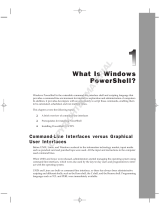
Chapter 1: Introduction to Dell Command | Monitor 10.5............................................................... 5
What's new in this release for Dell Command | Monitor 10.5...................................................................................5
Dell Command | Monitor overview.................................................................................................................................. 5
Chapter 2: Windows SMM Security Mitigations Table (WSMT) Compliance...................................7
Chapter 3: Standards and protocols for Dell Command | Monitor 10.5........................................... 8
Chapter 4: Use case scenarios using Dell Command | Monitor 10.5................................................ 9
Scenario 1: Asset management........................................................................................................................................ 9
SCCM integration .........................................................................................................................................................9
Scenario 2: Configuration management.........................................................................................................................9
Scenario 3: Health monitoring.........................................................................................................................................10
Monitoring system alerts through operating system Event Viewer, Syslog, or CIM indication................10
Scenario 4: Profiles............................................................................................................................................................10
Asset profile...................................................................................................................................................................10
Battery profile................................................................................................................................................................11
BIOS management profile........................................................................................................................................... 11
Boot control....................................................................................................................................................................11
Base desktop mobile....................................................................................................................................................12
Log record......................................................................................................................................................................12
Physical asset................................................................................................................................................................12
System memory profile............................................................................................................................................... 12
Chapter 5: Using Dell Command | Monitor 10.5............................................................................ 13
Polling interval setting...................................................................................................................................................... 13
RAID status reporting........................................................................................................................................................13
Monitoring the Dell client systems.................................................................................................................................13
Application log for Dell Command | Monitor for Linux.............................................................................................. 14
Detecting advance format drives...................................................................................................................................14
Boot configurations........................................................................................................................................................... 14
DCIM_AssetWarrantyInformation............................................................................................................................15
DCIM_BootConfigSetting.......................................................................................................................................... 15
DCIM_BootSourceSetting......................................................................................................................................... 15
DCIM_OrderedComponent........................................................................................................................................15
DCIM_Smart Attribute................................................................................................................................................16
DCIM_ThermalInformation ....................................................................................................................................... 16
Changing the system settings........................................................................................................................................ 16
Setting BIOS attributes in a system running Windows using PowerShell commands.................................16
Setting BIOS attributes in the system running Linux.......................................................................................... 17
Changing the boot sequence.................................................................................................................................... 19
Shutting down and restarting the Windows system remotely......................................................................... 20
Getting system time value on Windows system remotely.................................................................................20
Contents
Contents 3






















